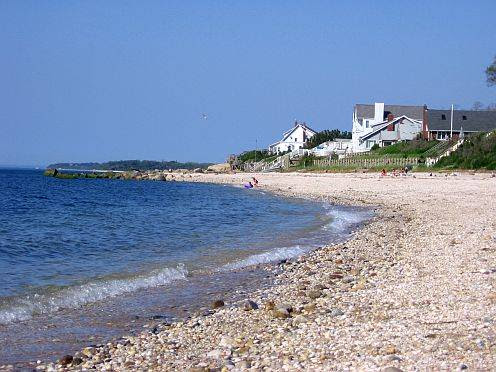
Visitors to the Long Island Aquarium may now see four otter pups in their outdoor habitat. The pups, two male and two female, have been secluded indoors with the mother to bond and nurse since they were born on Feb. 6 at the aquarium. But now that the pups’ eyes have opened, animal care staff at the aquarium feel comfortable allowing the mother to take the pups outdoors.
"They’re adorable," said Darlene Puntillo, marketing director for the aquarium, in Riverhead. "They seem to be little lumps of cuteness. They don’t have much of a personality yet. They look like puppies."
The mom — named Flo — will decide whether and when to bring one or all of the pups outside or may keep them inside by the day and even by the hour, said Candyce Paparo, the aquarium's senior curator of mammals, birds and reptiles. But as soon as Flo was given access to the outdoor habitat called Otter Falls on Wednesday morning, she carried the pups outside and rested with them in a bunch of hay.
"We weren’t sure what she was going to do," Puntillo said. "We knew she would be excited to get back outside on habitat. She’s a doting mom. We thought she would go alone for a swim but she wanted those babies with her. She brought them out and hunkered down with them."
The pups have not yet been named, and they will likely stay at the aquarium for up to a year as they learn to walk and swim and get to know their father, an otter named Stark. The babies are the second generation born at the aquarium; Stark was also born there to now-deceased otters Peanut and Jelly.
"They are living life as they should," Puntillo said of the fact that Stark and Flo chose to mate. "When things are as they should be in nature, that’s a success for our care team."
North American river otters are impregnated about 330 days before giving birth. They have "delayed implantation," Paparo explained. The egg does not implant in the uterus right away, she said. Once it implants, then the actual gestation takes place, which lasts 68 to 73 days. "The otter will mate, and a year later the female will give birth," she said.
The aquarium staff knew they might have pups this season, Paparo said. They also weigh the animals regularly. "It did seem like she was getting a little bit more of a belly and a little weight gain," Paparo said.
The aquarium will eventually find other homes for the babies. "This species doesn’t congregate in huge groups," Paparo said. "The offspring only stay for a year or so and then they’ll go off on their own. I’ve already worked with other zoos and aquariums that might want to bring in another animal."
From Newsweek.
Related articles
 Lifestyle
LifestyleJul 30, 20253 mins reading
Weekend Getaway Ideas Close to Your New Home
Discover 5 easy weekend getaway ideas near your new Long Island home — from beach escapes to wine country retreats. No flights needed, just local luxury.
Read more
 Lifestyle
LifestyleJul 23, 20253 mins reading
Top Country Clubs & Golf Courses on Long Island
From iconic Bethpage Black to private country clubs in the Hamptons and North Shore, discover the top golf courses on Long Island that luxury homebuyers love.
Read more
 Lifestyle
LifestyleJul 16, 20254 mins reading
The Best Beaches, Parks & Trails Near the North Shore
Discover the best beaches, parks, and nature trails near Long Island’s North Shore—perfect for weekend escapes and outdoor living all year round.
Read more